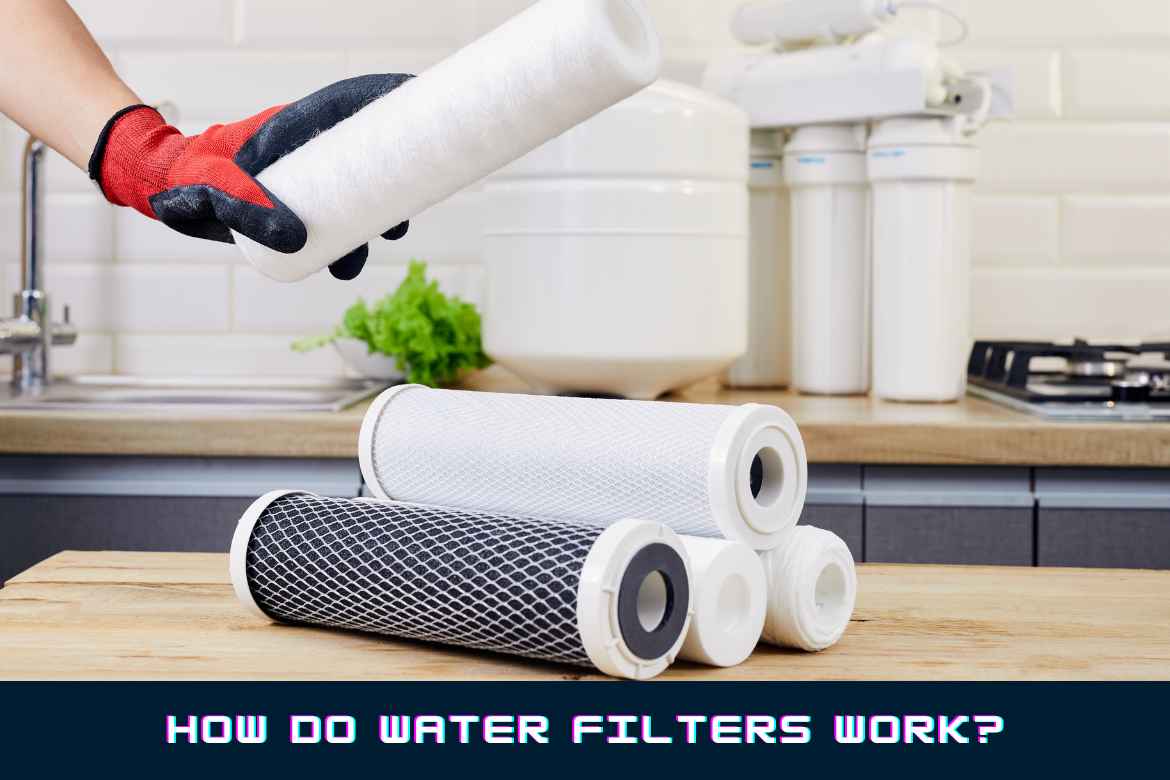Imagine waking up one sunny morning, feeling thirsty, and heading to your kitchen for a refreshing glass of water. You fill your glass, take a sip, and suddenly, a thought crosses your mind. Is this water safe to drink? What kind of minerals or chemicals are included in this? These are questions that should never be left unanswered, for the simple reason that water is the essence of life, and access to clean, safe drinking water is vital for our lives.
In today’s world, where water pollution and contamination are real and persistent threats, understanding how to safeguard the quality of the water we consume is paramount. This is where water filters come into play as our unsung heroes, quietly working to ensure that every drop we drink is free from harmful contaminants.
So, whether you’re curious about the magic behind your kitchen faucet or contemplating the purchase of a water filtration system, read on. By the end of this article, you’ll have a clear understanding of how a water filter functions and why they are indispensable tools in the quest for clean, potable water. Let’s quench your thirst for knowledge about water filtration and answer the question, “How do water filters work?”
Table of Contents
ToggleTypes of Water Filters
1. Mechanical Filters
- How They Work: Mechanical filters are the sturdy defenders of water purity. They employ physical barriers, such as screens, sieves, or membranes, to trap and remove contaminants from your water. Imagine these filters as miniature bouncers at the entrance to your water glass, preventing unwanted particles from entering the party.
- Examples: Mechanical filters come in various forms, with two common types being sediment filters and ceramic filters. Sediment filters work to remove larger particles like sand, silt, and rust, while ceramic filters use tiny pores to filter out impurities. They are often found in portable water filter systems, making them ideal for outdoor adventures too.
2. Activated Carbon Filters
- How They Work: Activated carbon filters are like sponges for your water, but in a supercharged form. They contain activated carbon, which is excellent at adsorbing (not absorbing) organic compounds and chemicals. When water passes through, these filters attract and hold onto impurities, leaving your water cleaner and better-tasting.
- Versatility: What sets activated carbon filters apart is their versatility. They are adept at removing a wide range of common contaminants, including chlorine, volatile organic compounds (VOCs), and bad odors. This makes them a popular choice for improving the taste and odour of tap water as well.
3. Reverse Osmosis Filters
- How They Work: Reverse osmosis (RO) filters employ a clever trick known as “reverse” osmosis to separate contaminants from water. These filters use a semipermeable membrane that allows water molecules to pass through while blocking larger molecules and impurities. Think of it as a super-fine sieve that only permits the purest water molecules to get through.
- Effectiveness: RO filters are known for their high effectiveness in purifying water. They can remove a wide range of contaminants, including heavy metals, minerals, and even some bacteria and viruses. RO systems are often used for under-sink filtration in homes too.
4. UV (Ultraviolet) Filters
- How They Work: UV filters take a high-tech approach to water purification. They use UV-C light to disinfect water by disrupting the DNA of microorganisms, rendering them unable to reproduce or cause harm. Essentially, it’s like giving these tiny troublemakers a lethal dose of sunshine.
- Role in Elimination: UV filters are especially effective in eliminating bacteria, viruses, and protozoa, making them a reliable choice for disinfecting water. They’re often used in combination with other filtration methods for comprehensive water treatment as well.
5. Ion Exchange Filters
- How They Work: Ion exchange filters employ a chemical process to remove ions like calcium and magnesium from your water. They swap these ions with other less troublesome ions, typically sodium or potassium, through a resin bed. This exchange process softens the water, reducing its mineral content.
- Water Softening: The primary role of ion exchange filters is water softening. If you’ve ever wondered why your water feels “hard” or leaves limescale deposits, ion exchange filters can help tackle these issues, making your water gentler on your skin and appliances.
6. Oxidation-Reduction Filters
- How They Work: Your water’s pollutants undergo a chemical transformation thanks to oxidation-reduction filters. They frequently use materials like catalytic carbon or potassium permanganate to increase reactions further, which changes toxic compounds into less dangerous ones in double-quick time too.
- Examples: chlorine, chloramine, and hydrogen sulphide are among the toxins that these filters excel at eliminating. Oxidation-reduction filters work their magic by altering the chemical composition of these compounds over time, making them less harmful and easier to deal with in the long run.
The Filtration Process
Now that we’ve acquainted ourselves with the diverse cast of water filters, it’s time to pull back the curtain and reveal the inner workings of these remarkable devices. Water filters perform their magic through a well-orchestrated process, ensuring that the water that reaches your glass is as pure as possible. So, how do water filters work, you ask? Let’s walk through the process step by step.
- Step 1: Inlet The journey begins at the inlet, where water from your source—whether it’s tap water, well water, or another water supply—enters the filtration system. At this stage, the water may still contain a medley of impurities, from sediment to chemicals and microorganisms.
- Step 2: Pre-Filtration Before the water ventures further into the filter, it often encounters a pre-filtration stage. This initial step is crucial for mechanical and activated carbon filters. Mechanical filters, like sediment filters, use their physical barriers to trap larger particles at this point. Activated carbon filters, on the other hand, begin adsorbing organic compounds and chemicals right from the start.
- Step 3: The Heart of Filtration The heart of the filtration process lies in the filter medium itself. Here, water encounters the primary filtration mechanism, whether it’s a semipermeable membrane in reverse osmosis filters, an activated carbon bed, or other specialised materials. This is where the magic happens as contaminants are captured, trapped, or chemically altered.
- Step 4: Contaminant Removal As water passes through the filter medium, contaminants are removed or transformed. Mechanical filters physically trap impurities like sediment and particles, leaving behind clean water. Activated carbon filters adsorb organic compounds and chemicals, while reverse osmosis membranes block larger contaminants. UV filters unleash their germ-zapping UV-C light, neutralising microorganisms’ DNA and rendering them harmless.
- Step 5: Outlet After undergoing the filtration process, the purified water makes its way to the outlet. This is where you access the clean, safe water you desire, ready for drinking, cooking, or any other purpose you have in mind.
Maintenance and Replacement
1. The Importance of Regular Maintenance
2. Guidelines for Maintenance
- Cleaning and Pre-Filter Replacement: For filters with pre-filtration stages (like mechanical or sediment filters), start by regularly checking and cleaning the pre-filter. This simple step can significantly extend the lifespan of your main filter. Replace pre-filters according to the manufacturer’s recommendations.
- Changing Filter Cartridges: Filter cartridges, whether activated carbon or reverse osmosis membranes, have a finite lifespan. Follow the manufacturer’s instructions for replacing cartridges, usually specified in terms of gallons filtered or time elapsed. Failing to replace cartridges on time can result in reduced filtration efficiency.
- Cleaning and Sanitising: Some filters may require periodic cleaning or sanitising to remove buildup and prevent bacterial growth. This is particularly important for UV filters, which need to be free from obstructions to effectively disinfect water.
- Monitoring Water Quality: Regularly test the quality of your filtered water to ensure it meets your expectations. This helps you identify any decline in performance and take corrective action promptly.
3. Emphasising Proper Maintenance
Proper maintenance is the key to ensuring that your water filter continues to do its job effectively. Neglecting maintenance not only compromises the quality of your filtered water but also reduces the longevity of your filtration system. It’s an investment in both health and sustainability.
Quick Tip: Consider keeping a maintenance schedule or setting reminders to help you stay on track with filter changes and cleanings. Many manufacturers provide user-friendly guidelines and tools to make the maintenance process hassle-free.
Choosing the Right Water Filter
Now that we’ve explored the inner workings and maintenance of water filters, it’s time to address a fundamental question: How do you choose the right water filter for your specific needs? Selecting the perfect filter involves considering several crucial factors that ensure you get the most out of your investment while enjoying clean, safe water. Let’s dive into some essential tips for making this decision.
- Understand Your Water Quality: The first step in choosing a water filter is understanding the quality of your water supply. Is your water source prone to high levels of sediment? Does it have a noticeable chlorine taste? Or are you concerned about contaminants like lead or bacteria too? Knowing your water’s unique characteristics will help you narrow down the type of filter you need.
- Identify Your contaminants: Different filters excel at removing specific contaminants, so it’s essential to identify which impurities are of concern. For example, activated carbon filters are excellent for removing chlorine and improving taste, while reverse osmosis systems are effective against a broader range of contaminants, including heavy metals. Knowing what you’re up against is key to choosing the right filter.
- Consider the Flow Rate: Flow rate matters, especially if you have a household with high water demand. Consider the number of people in your household and how often water is used simultaneously (e.g., showering, laundry, and dishwashing). Ensure that the filter you choose can provide an adequate flow rate to meet your daily water needs.
- Installation Options: Different filters have varying installation requirements. Some can be installed under your sink, while others may require professional installation or a dedicated water line. Think about the available space and installation convenience. Portable options are also available if you require flexibility.
- Budget and Operating Costs: Consider both the upfront cost of the filter and its long-term operating expenses. Some filters may have a higher initial investment but lower ongoing costs. On the other hand, filters with lower upfront costs may require more frequent cartridge replacements, which can add up over time.
- Certification: Look for filters that have been independently tested and certified by organisations like NSF International. Certification ensures that the filter meets specific standards for contaminant reduction, providing added peace of mind about the filter’s effectiveness.
- Ease of Maintenance: Choose a filter that aligns with your maintenance preferences and capabilities. Some filters require regular cartridge changes and periodic cleanings, while others are relatively hands-off. Consider how much effort you’re willing to invest in filter maintenance.
- Environmental Impact: For those concerned about environmental impact, consider filters with reusable or long-lasting components too. Reducing the number of filter cartridges that end up in landfills can be a sustainable choice.

